
ST. GEORGE — The story of the Mormon Battalion began in early 1846, amid growing opposition and prejudice to the relatively new religious denomination, The Church of Jesus Christ of Latter-day Saints.
The most strident opposition occurred in Illinois with the forceful expulsion of the Latter-day Saints from Nauvoo by mobs posing as state militia. There, escalating violence by non-Mormon vigilantes had reached a crescendo. Nauvoo was one of the largest cities in Illinois, with a Mormon population of 11,000. However, in September, more than 200 Mormon properties were destroyed in an attempt to drive them from the area.
“Those of us who can remember when we were compelled to abandon Nauvoo, when the winter was so inclement, know how dark and gloomy the circumstances of the Saints were, with the mob surrounding our outer settlements and threatening to destroy us,” Mormon Battalion member George Q. Cannon said in a diary entry sometime after the winter of 1846.
“The word was to cross the Mississippi and to launch out into an unknown wilderness – to go where no one knew,” Cannon added. “Who knew anything of the terrors of the journey thither, or of the dangers that might have to be met and contended with? … (We moved) out with faith that was undisturbed by (these) unknown terrors. It was by faith that this was accomplished.”
Some historians believe Cannon overstated his concerns. Bingham Young and other church leaders had studied every available map and travel account of the Rockies in the months before departing Nauvoo.

Even before the exodus from Nauvoo, tensions had been escalating between the United States and Mexico over the disputed Territory of Texas.
Texas declared its independence in 1836, but Mexico did not accept its sovereignty and regarded it as a rebellious province. The relations between the two countries deteriorated as the United States intervened and sent troops to a contested area near the Rio Grande River. The United States claimed that the Rio Grande was the border of Mexico, while Mexico maintained that the border was further north at the Nueces River. About 75,000 Mexican citizens lived north of the Rio Grande at that time.
To avoid a war, President James K. Polk tried to buy the disputed lands of “Nuevo Mexico” and what would become California from Mexico for $25-30 million (worth over $1 billion in 2024). He also offered to cancel $3 million in debts that Mexico owed to U.S. citizens after its independence war. But Mexico rejected the offer because of its political turmoil and national pride.
On April 25, 1846, a 2,000-man Mexican cavalry unit attacked a detachment of U.S. dragoons under the command of Brig. Gen. Zachary Taylor (America’s 12th president) patrolling the disputed land between the Rio Grande and the Nueces River, killing 11 and capturing most of the soldiers. Following the dismantling of the U.S. force along the Rio Grande River, Polk ratcheted up the pressure demanding that the U.S. Congress act.
“Mexico has passed the boundary of the United States, has invaded our territory and shed American blood upon the American soil,” Polk said. “She has proclaimed that hostilities have commenced, and that the two nations are now at war.”
After a short debate, Congress declared war on Mexico on May 13, 1846. Mexico reciprocated with its own declaration of war 10 days later.
The Mexican-American War (1846-48) had begun.
James K. Polk
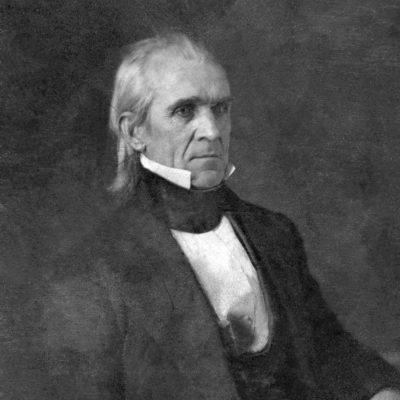
During his presidency (1845-49), Polk championed the idea of extending America’s sphere of influence across the North American continent and negotiated control of the Oregon Territory (now Oregon, Washington, Idaho and Montana), which was under joint American and British rule. The United States nearly went to war with Britain over Oregon, but the two powers ultimately agreed to partition the territory. Polk also desired to wrestle control of California from Mexico.
To accomplish his objectives, Polk used a combination of nationalistic browbeating, a belief in America’s religious dominance and the lack of fear to use the growing nation’s capable military assets to achieve his goals.
Although the U.S. never lost a major battle during the war, the victory came at a cost.
The war involved about 79,000 American troops, of which 13,283 died – a mortality rate of nearly 17%, higher than in World War I and World War II. The Mormon Battalion, however, had significantly fewer losses than many other U.S. units in the Mexican-American War; only 23 of its members died, a death rate of about 4.6%.
Although this data holds up to scrutiny, they include deaths from “other causes” besides combat. If considering only the deaths and injuries from fighting, the U.S. casualties drop significantly to 1,733 dead and 4,152 wounded. The total number of U.S. soldiers who died from all causes during the war was 17,435.
The Mexican side has less reliable records of its casualties.
It is estimated that about 5,000 Mexican troops died in battle and another 20,000 were wounded. Additionally, around 10,000 Mexican soldiers went missing during the conflict. These numbers include military and civilian deaths from both combat and violence. The total death toll for Mexico, considering all factors, may have reached 25,000.
As the nation prepared for war, the Mormon pioneers built temporary settlements along the middle section of the Missouri River. In July 1846, they encountered a U.S. Army expedition in the Iowa Territory.
There, U.S. Army Capt. James Allen (later promoted to Brevet lieutenant colonel) and an escort of soldiers arrived at Mount Pisgah, Iowa, to begin enlisting a Mormon Battalion for a potential war against Mexico. July 16, 1846, most of the battalion was officially enlisted into military service.
The initial reaction to the call for Mormon men to join U.S. Army was overwhelmingly negative.
Some feared that this call was part of a government conspiracy to determine their strength and to obstruct or prevent their migration west. However, by early June, Brigham Young realized after struggling through the rain-soaked quagmires of southern Iowa, that the Saints could not safely reach the Rocky Mountains that year as planned. The proposed enlistment, Young recognized, could bring dependable pay that would help purchase supplies. The arraignment with the U.S. government would also ease fears about Mormon loyalty to the United States.
“The battalion members believed in what they were doing,” said Teresa Orton, a descendant of battalion member Jacob Mica Truman. “They believed in their church, they believed in the leadership, Brigham Young … and they believed in themselves. Everyone banded together for the good of the group. They were not quitters.”

Concerned about thousands of Mormons heading into enemy territory, Polk ordered U.S. Army officials to recruit a “few hundred Mormons” for the war effort. The president said he hoped “to conciliate (the Mormons), attach them to our country, & prevent them from taking part against us.”
Polk’s reasoning: “We’ve already got these people halfway out there,” said Brandon Metcalf, Latter-day Saint Church historian. “We can pay them a little bit and hopefully they will remain loyal to the U.S. It’s so easy to look back with hindsight. I think Polk probably assumed (the Mormons) could get into the fight as needed. I think they would have been expected to fight if necessary.”
Polk wanted to compromise with the Mormons, so he agreed to fund a battalion of Mormon men in Iowa who would join Brig. Gen. Stephen W. Kearny’s Army of the West. President Polk approved this enlistment despite several concerns. Chief among them was the risk of internal conflict because most of Kearny’s soldiers were from Missouri, and the Mormons and Missourians had a history of hostility and distrust.
Despite great debates and much anxiety, Brigham Young approved the formation of a battalion consisting of five companies, each with approximately 100 men.
The first reaction from the Mormon pioneers ranged from outrage to disbelief.
“I felt indignant toward the Government that had suffered me to be raided and driven from my home,” said battalion member Daniel B. Rawson, in a diary entry. “I made the uncouth remark that ‘I would see them all damned and in Hell.’ I would not enlist. On the way to (Potawatomi – present-day Council Bluffs, Iowa) we met President Brigham Young … calling for recruits. (Young) said the salvation of Israel depended on the raising of the army. When I heard this, my mind changed. I felt it was my duty to go.”
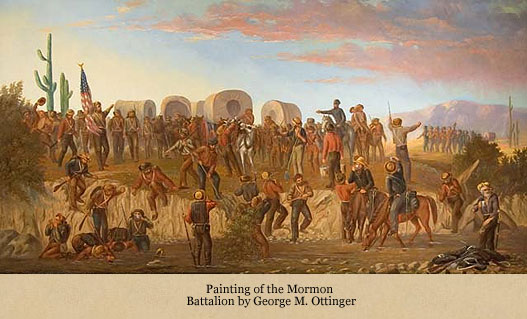
Once the saints understood the wishes of Young, the quota of men was obtained in about three weeks.
“None of the men joined when the Army asked,” said Laura Anderson, executive director of the Mormon Battalion Association. “They joined because of Brigham.”
Official rolls record an enlistment of 497 volunteers. In addition, as many as 80 women and children marched with the battalion.
The battalion had a fondness for their first commander, Lt. Col. Allen, who had a reputation as a fair and honorable leader of men. However, Allen fell ill and died soon after they departed from Leavenworth. His successor, 1st Lt. Andrew Jackson Smith, regular Army, became very unpopular. They didn’t have a permanent leader until Oct. 13, 1846, when Lt. Col. Philip St. George Cooke joined the battalion almost two weeks before it reached Santa Fe.
The fifth woman
According to LDS Living, at least 30 women traveled with the battalion as nurses, laundresses, cooks, maids and some as companions for their husbands. Researchers knew that the five women, wives of leaders in the battalion – two captains and three sergeants – were permitted to travel to California. Four of these women have been identified, but the name of the fifth woman has been more elusive.
One clue led to finding the fifth woman’s identity – two sergeants, last name of Brown, started their march with wives named Mary. But only one Mary Brown is listed on the records of battalion members who returned to Utah. This question left researchers unclear about what happened to the other Mary Brown. Did she also return to Utah, or did she carry on to California?
Over time, researchers found evidence that suggested the other Mary Brown (Mary Clark Steele Brown) accompanied her husband to California, making her the elusive fifth woman. Two of the women who reached San Diego were expecting during the march. Melissa Burton Coray Kimball and Lydia Ann Edmunds Hunter both arrived in California and wished for healthy babies.
The nausea of early pregnancy made traveling harder for Kimball.

Oct. 2, 1847, after the battalion was discharged, Kimball gave birth to a son, but the newborn only lived a few days.
Unfortunately for Hunter, her pregnancy wouldn’t end any better than Kimball’s. According to historical records, after completing the march to San Diego, California, Lydia Hunter, the wife of Capt. Jesse Hunter of Company B, died April 26, 1847, shortly after childbirth. According to her gravestone Hunter was 24.
The military doctor, John Griffin provided an unsettling description of her death.
“Last night the wife of Captain Hunter died of Typhoid fever or rather I think a malignant form of Quotidian fever – a form of intermittent malarial fever,” Griffin said. “The attack was (ushered) in with severe rigors, some six days ago with great difficulty of breathing and oppression, followed by high fever.”
At about 11 a.m. each day the same attack came with cramps and “irregular nervous twitchings. Her brain became very much excited Delirium for two days previous to death and deafness. She finally died last night about 1 (a.m.) in great pain.”
Hunter’s newborn son Diego survived and was adopted by Juanita Machado Wrightington, a resident of San Diego and Hunter’s midwife. Although the date of his death is unknown, census records indicate that Diego was living in Los Angeles in 1880.
The United States, now at war with Mexico, had authorized funding for 50,000 volunteers to join the war effort.
June 2, 1846, Polk wrote in his diary: “Kearny was … authorized to receive into service as volunteers a few hundred of the Mormons who are now on their way to California, with a view to conciliate them, attach them to our country, and prevent them from taking part against us.”
When the battalion left Council Bluffs, Iowa, on July 20, 1846, they were joined by more than 30 women and 50 children. Their destination was San Diego.
“We were mustered into service on the 16th of July 1846,” said Mormon Battalion Sgt. Maj. James Ferguson in 1855, at the First General Festival of the Mormon Battalion in (the) Salt Lake Valley, as reported by Daniel Tyler, Mormon Battalion member and author of “A concise history of the Mormon Battalion in the Mexican War, 1846-1847.”
“A few hurried preparations, and the gray-haired old men and striplings marched off merrily as our commander ordered the music to play a hasty farewell to ‘the friends we left behind us,'” Ferguson added.
By the time the battalion arrived in California – Jan. 29, 1847 – the war was basically over, but only in California. ‘Old’ or ‘Lower’ Mexico was still being hotly contested with at least four major battles taking place after January 1847.
Although armed conflicts in California had ceased by the time the Mormon Battalion reached San Diego, only halfway into the terms of their service, the members shared a common dilemma, each still owed six months of military service to the U.S. government. Battalion members signed up for one year, with the goal of taking and holding California. Polk’s diary makes this goal clear. At the time, some received an assignment to stay in San Diego, where they worked on public service projects. Most went to Los Angeles to help build Fort Moore as well as guarding Cajon Pass, a primary north-south route through the San Bernardino Mountains.
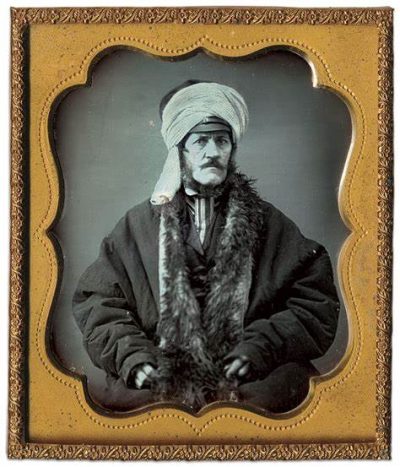
“History may be searched in vain for an equal march of infantry,” said Cooke in his diary upon arriving in San Diego. “With crowbar and pick and ax in hand we have worked our way over mountain and hewed a passage through a chasm of living rock more narrow than our wagons. … Thus marching half naked and half fed and living upon wild animals, we have … made a (trail) of great value to our country.”
The 37-year-old Cooke, a West Point graduate, class of 1827, was an imposing figure, standing 6-foot-4. He was known to his troops as a strict disciplinarian, rigid taskmaster and thorough planner but always fair to his men. The battalion and its non-Mormon officers eventually came to respect one another. Historians have noted that there was a lot of hatred at times. The men respected Cooke, but they probably wouldn’t have invited him over for dinner.
Above all else, Cooke was adamant about following orders at any cost. His devotion to military structure afforded him zero tolerance for failure, unprofessionalism or disobedience.
It would have injured Cooke greatly to learn his son-in-law, James Ewell Brown Stuart “J.E.B. Stuart,” prior to the Civil War resigned his U.S. Army commission to side with the Confederate States of America.
At that time, the Civil War was still 18 years away. Cooke’s immediate task was to lead a poorly equipped and untrained force of civilian volunteers on a grueling and perilous journey. The battalion followed what would later be known as “Cooke’s Wagon Road,” creating the first transcontinental route across the southwest. This trail would become a vital passage used by emigrants and freighters to the Pacific Ocean and the Southwest.
Cooke’s Wagon Road wound through New Mexico and included portions of existing historic trails such as the Juan de Anza’s route, Camino Real de Tierra Adentro, the Janos Trail, Old Spanish Trail, Trappers Trail and the Santa Fe Trail.
Although the battalion never engaged in combat, the trek to San Diego took its toll. Typical of the suffering battalion endured were diary entries of George Washington Taggart.
At the age of 29, Taggart enlisted in Company B in the Mormon Battalion, one of approximately 500 men who set out between July 16 – 22, 1846, commenced an “unparalleled” march on foot across seemingly “endless prairies, mountain ranges of little consequence and through the barren deserts of the Southwest to shores of California.”
Taggart enlisted as a musician “a fifer,” playing an instrument he made himself.
“I (felt) … as though I made as great a sacrifice as I could wel make, in that I have forsaken for the time My possessions My family and at the risk of life. (Started) for Mexico as a United States soldier, with 500 of My Brethren in order to show that the Blood of my Grandfathers who fought and bled in the revolutionary war and the spirit of liberty and freedom still courses in the veins of some of their posterity that are called Mormons,” wrote Taggart upon his enlistment, and recorded in his dairy.
Of the original battalion, 335 reached California.
September 4 – By now, “Many of the Brethren were sick with fevers & agues,” Taggart said. “I will here mention (on the authority of William Evans (Private, Co. B) (and others) one of my mess mates who was beginning to recover from an attack of the chills & fever & had been riding in the baggage wagons, the only way provided for carrying the sick.”
Dr. George W. Sanderson – “Doctor Death”

“The principle Surgeon (Dr. George W. Sanderson) … came up with the wagons in the afternoon of the 4th & ordered the Sick to get out of the wagons and swore that not a Man should ride except by His permission & His permission would not be given except those returned sick would take his medicine He also said that if he knew of anyone prescribing any medicine to any sick Man without His orders that He would cut His damned throat,” Taggart said.
According to Sherman L. Fleek, a retired U.S. Army Lt. Col. and author of “History May Be Searched in Vain: A Military History of the Mormon Battalion,” Sanderson was many things, but a radical Mormon hater, that would rather kill than cure, he was not. Although there were instances of prejudice exhibited by non-Mormon members of the battalion, Sanderson was nothing more than a button-down Army-regular who was set in his ways of what constituted proper military decorum.
“It is absolutely false that his attentions were to kill Later-day Saints whether he was a Missourian or not, or a slave owner, two men died under his care,” Fleek said. “Sanderson’s journal was discovered in about 2005. There has been a real propaganda campaign against him for years and some Latter-day Saints are still on that bandwagon.”
Metcalf agreed.
Sanderson’s alleged mistreatment, malpractice and murder has been played up over the years, Metcalf said.
“There was a lot of bitterness towards Sanderson among the soldiers,” Metcalf said. “There was a lot of mistrust in government. Here’s this government who really hasn’t done anything for the Mormons and now its offensive to them if they’d even be asked to serve a country who abandoned them.”
In some accounts, Sanderson is described as a no-nonsense officer who treated everyone with the same degree of skeptical expectations, to a handful of others that described the doctor as a “premeditated murderer.”
Although Sanderson’s bedside manners may have been rough, arrogant and abusive to the Battalion volunteers, in stark contrast to a more benevolent form of interaction that prevailed in Mormon communities, Sanderson was following the standard medical practices of his time by giving calomel, arsenic and other military-approved drugs to soldiers who were sick. However, he faced opposition from Brigham Young and other church leaders who advised their followers to avoid the mineral-based medicines used by mainstream and military doctors.
Sanderson’s background as a farmer and slave-owner in Missouri might have influenced his alleged cruel attitude and apparent contempt for the Mormon soldiers. Sanderson supposedly uttered “harsh curses” and claimed that he would “send as many Mormons to hell as he could,” which obviously alienated him from the battalion.
Sanderson failed to appreciate or understand that respect from the troops is earned, not demanded.
But, as familiarity grew between the men and Sanderson, most of the venomous journal entries regarding the doctor’s personality and treatments abated about two months after he joined the battalion in late August 1846. Around this time (end of October 1846), the battalion enlistees were becoming more accustomed to the rigors and discipline of military life. Sanderson continued treating the soldiers throughout their march to San Diego and during their military stay in California.
Sanderson’s Mexican War journal gives no indication he held personal animosity towards the Mormons in the battalion. Despite the moniker “Doctor Death,” there were perhaps not more than five Mormon servicemen who took umbrage with Sanderson’s medical care.
However, according to his training, Sanderson used the conventional techniques of the time and would never have entertain the use of homeopathic remedies.
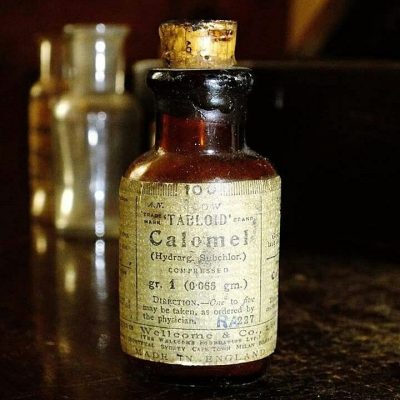
In Sanderson’s medical bag was Calomel – a mercury compound – used to ‘clean you out.’ The tasteless powder consisted of mercurous chloride packaged in paper to protect it from light which would cause it to decompose to deadly mercuric chloride. Taken over time or heavy doses would induce symptoms of mercury poisoning: salivation, bleeding gums, mouth sores and tooth loss. Calomel was a heavily used, all-purpose medicine used mainly as a laxative.
Sanderson also used other medicines such as arsenic as an all-purpose medicine. To make it more palatable, the combination of Calomel and arsenic were mixed in molasses. However, the Mormons did not appreciate Sanderson’s treatments, as they favored herbal medicines and relied on faith-healing.
“I must confess I have never seen just such a set of men together in my life, no discipline no subordination nor nothing else,” wrote Sanderson in his journal dated September 1846. “This Battalion will cost the Government more money in proportion than any Corps they have, and if not mistaken will render less service. The only way or plan the Government can adopt to make them useful is to put them to work building Fortifications.”
The first fatality among the enlisted ranks of the battalion occurred in the early morning hours of July 23, 1846, between midnight and 1 a.m.
Pvt. Samuel Boley, of Co. B, was one of the first men to enlist. He had become ill soon after leaving Council Bluffs. The assistant surgeon, Dr. William L. McIntyre, cared for Boley, but to no avail. The battalion was four days out from camp when Boley died.
“Boley was buried Thursday, July 23, 1846, at ten minutes before 7 in the morning under a tall tree,” said one onlooker. “He was wrapped in a blanket in a rough lumber coffin.” Though the exact location of their camp is not known with certainty, new analysis suggests a site near present-day Bartlett, Fremont County, Iowa.
Even today, Mormon histories describe Sanderson as a “mean, low, vulgar, vicious frontier quack, a despised person, a man without any virtuous traits, and a true Philistine among the Lord’s faithful.”
Lewis Dent, the civilian clerk to Maj. Jeremiah H. Cloud, paymaster, recorded his distressing observations in his diary.
“I saw athletic and vigorous men reduced, by thirst and fatigue, to the imbecility of children … their bodies attenuated and feeble; their faces bloated; their eyes sunken; their feet lacerated and bruised, mechanically moving forward, without a murmur and without an object; the latter having been lost sight of in the gloomy contemplation of their present helpless condition,” Dent said.
Jan. 21, 1847 – Eight days before reaching San Diego, Sanderson’s journal abruptly stops. To date, there has been no answer as to why.
Most historians believe Sanderson did not run out of paper, since there were mostly blank pages at the end of his writing and the doctor was known not to waste a line of space. He was not massacred by Indians, as one might guess from the last paragraph of his Journal. And no evidence exists claiming he was murdered by patients who thought him better burred six feet under.
But the events of 1846, can’t be viewed in isolation.
Medical care in the Mormon Battalion was also mirrored in other U.S. regiments. Military medical kits described for the Lewis and Clark Expedition (1803) and the Civil War (1861) contained a variety of medicines that can be characterized by their general uses. These types of medicines would most likely have also been used during the Mexican War (1846).
Bloodletting, blistering, purging and mercury use were common medical practices during the Civil War. They aimed to rebalance the humors (biological systems) of the body, as part of the “heroic era” of medicine. However, these practices were ineffective and often fatal. This was not a consolation for the Mormon Battalion members who endured Sanderson’s treatments, which they considered their own personal hell.
When a battalion history was published in 1881, Sanderson received a healthy dose of criticism, but recent research indicates his medical care influenced two or three of the 20 deaths recorded. Some put the number at 23, while others maintain that 25 battalion members died during their trek to California.
Although the battalion was largely made up from farmers, blacksmiths and other laborers, it was also studded with many soon-to-be significant leaders in the Mormon Church.
Daniel Tyler
Daniel Tyler, born in New York State on Nov. 23, 1821, would go on to become an influential leader with the church. Tyler and his wife Ruth were loyal, committed members of the Church of Jesus Christ of Latter-day Saints and participated in many of the early events in church history. After being forced to leave Nauvoo in February 1846, the couple proceeded to Council Bluffs, where preparations were underway for the migration west. It was at this time that the Mormon Battalion was formed. Tyler was among the first to volunteer.
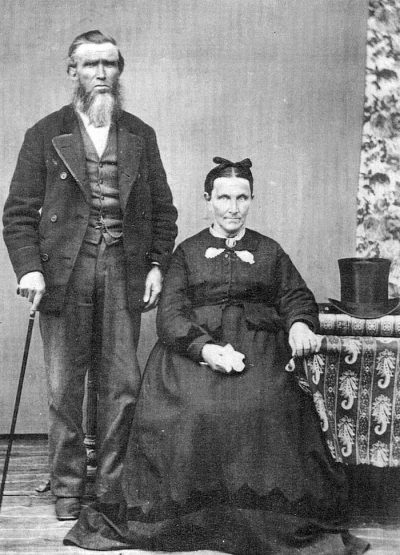
Opinions about Sgt. Daniel Tyler varies.
Tyler’s account of life in the Mormon Battalion has been both praised and criticized. Some consider it a trustworthy source, while others doubt its validity. Nevertheless, Tyler aimed to reveal the difficulties that each battalion member endured, but as with any historical account, biases and personal history influence how reality is perceived.
Author and historian Norma Ricketts described Tyler, in her book “Mormon Battalion: United States Army of the West, 1846-1848,” as having “manners (that) were generally courteous and mild.” However, Ricketts also noted that Tyler was “well calculated to deceive.”
While some view Tyler as courteous but deceptive, others recognize his contributions to the battalion’s history.
August 1846 – “It was customary every morning for the sick to be marched to the tune of ‘Jim along Joe’ to the Doctor’s quarters and take their portion from that same old iron spoon,” Tyler said in his book. “It was believed by many that this spoon had been thrown away by some soldier at the garrison and picked up by the Doctor, thinking a new one would either be too expensive or too good for the Mormons to use in taking their medicine.”
So determined was the doctor, Tyler said, that the men took Sanderson’s calomel and arsenic treatments … “these being all, or nearly all, the medicines he used” … that he threatened to cut any man’s throat who would administer any medicine without his orders.
If the men chose not to take their medicine quietly, they feared it would be forced down their throat, and if any of the men spit out the medicine they were labeled “insubordinate” and promptly dealt a swift punishment. It was believed that those who recovered had been cured by faith; while those who died had “clearly been murdered,” Tyler added.
What Sanderson failed to appreciate was that respect is earned not demanded.
Although the battalion faced more deaths, on the night of Sept. 16, 1846, a glimmering omen was seen low in the northeastern sky.
“On the evening of Brother Phelps’ death, what appeared to be a star was noticed in the east as dancing in the air,” Tyler said in his book. “It continued to move both north and south, up and down; it was directly in the course we had traveled. It attracted considerable attention while it remained in sight, and finally disappeared below the eastern horizon. Look up at the great comet.” What the men of the battalion most likely saw in the night ski was Biela’s Comet.
After weeks of reaching endless way points along the battalion’s march west, on Oct. 7, 1846, the battalion camped near the Spanish village of Las Vegas, N.M.
October 9 – 12 – The battalion reached Santifee (Santa Fe). Taggart was still carrying a letter he had written to his second wife Fanny on Sept. 19, 1846. Nearly a month later he added a heartfelt desire to be with his family.
“I have caried this letter which I supposed I had finished at the time I feel anxious to hear from you & My Little Daughter and I am more anxious to see you, but distance and circumstances forbids Me the latter privilege, but I trust that Our minds and feeling are not separated although distance between us may intervene,” Taggart wrote.
Holding fast to his covenant of marriage, Taggart sent $19.04 to his family, keeping $2.60 for himself.
“I wish I could send you a thousand dollars but that you know is out of the question,” he said. “My health is good and I am blessed, and I do not forget to remember you in My prayers to the Lord, be faithful & true and again (I’ll) meet you.” A note was added on the outside of this letter: “Have just learned that We have to take up a line of March tomorrow Morning without receiving any of our wages consequently I shall send no money with this letter.”
Taggart soldered onward.
The Battle of the Bulls
December 11 – “Continuing down the banks of the San Pedro River the battalion made camp,” Taggart said.
Then an unlikely scenario unfolded when a herd of bulls stampeded into camp.
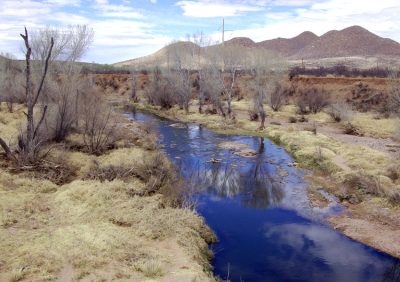
“The animals, congregated on the line of our route, on hearing the rumblings of our approaching wagons … some ran off in a fright. Others, however, to gratify their curiosity, perhaps, marched towards us, as if bent upon finding out who dared to intrude upon their quiet retreat. Their terribly beautiful forms and majestic appearance were quite impressive,” Taggart said in his diary.
As the troops approached, the animals became aggressive.
“The roar of musketry was heard from one end of the line to the other,” Taggart added. “One small lead mule in a team was thrown on the horns of a bull over its mate on the near side, and the near mule, now on the off side and next to the bull, was gored until he had to be left with entrails hanging a foot below his body. One or two pack-mules were also killed.”
For a measure of defense, the men climbed upon the wheels of the wagons and poured a “deadly” fire into the enemy’s ranks. During the melee, one bull was shot and fell near one of the butchers, Robert Harris. Upon seeing an easy kill, Harris was reported to run to cut the bull’s throat. When the animal “bounded” to his feet, it caught the butcher’s cap on his horn and ran off. Harris was quick behind shouting, “Stop you thief; I’ll have some beef.” The undeterred butcher pursued the animal about 75 yards when it again fell and “the fatal knife quickly ended all disputes.”
The dispute Harris had with his next meal was recorded in numerous first-hand journals.
At the end of the ruckus several men were injured, some seriously. At least one mule was disemboweled, wagons were overturned and damaged, and at least nine bulls were killed. The exact number of bulls shot is not known, but it was probably less than 20. Some accounts put the number at about 60 with one account placing the number at 80 killed outright.
“It is a magnificent sight to see a Buffalo Bull die,” Sanderson said. “They are remarkably tenacious of life (and) appear to part with it very reluctantly.”
Dec. 16, 1846 – Approaching Tucson, in present-day Arizona, the Battalion prepared for battle with a small detachment of provisional Mexican soldiers. The Mexicans retreated as the U.S. battalion approached. Tucson was taken without a shot. Not one to misrepresent the truth, Cooke never considered the encounter as capturing the town and never made any claim of the sort.
Jan. 9, 1847 – The battalion was 250 miles from San Diego. During the next two days the battalion safely crossed the swift running Colorado River with the teams and wagons intact.
“We resumed our journey west, We travelled 15 miles & Encamped at …
According to the George Washington Taggart Family Organization, this is the last entry in Taggart’s journal.
It is possible journal entries are missing since there are blank pages following this entry, but it is also possible Taggart’s physical condition was so poor that he could no longer continue writing.
The Final 100 Miles
The last part of the battalion’s journey to California was particularly difficult.
January 17 – “Many, many men had no shoes,” Ricketts said in her book. “They wrapped rawhide around their feet and tied it in place. Others wrapped clothing around their feet for protection against burning sand in the daytime and freezing cold at night. The men were used up from thirst, fatigue, and hunger; there was no talking. Some could not speak at all, their tongues were so swollen and dark. Many had scurvy. Sixteen more mules gave out.”
January 19 – The battalion struggled over a difficult pass (now called Campbell Grade), made an 180º turn to the east, followed a dry creek bed and then encountered a narrow gorge, subsequently named Box Canyon in the Anza-Borrego Desert. The wagons could not pass through the narrow cliffs, so the men had to take apart two of them and carry them by hand. They also carved out the cliff sides with tools such as crowbars, axes, spades and shovels to make room for the other five wagons.
One account added, “A 20-foot wall of rock then had to be bypassed by hewing a large rock enabling the wagons to climb out of the creek bed and traverse along a mountain slope before reentering the creek bed, which led to Blair Valley, but unfortunately, there was another boulder-laden ridge to traverse.” This path would later become known as the Foot and Walker Pass because later stagecoach passengers had to disembark and walk over the ridge to enable their coach to be pulled and pushed over the rocky gap with ropes and “shoulders (put) to the wheel.”
Today, more than 175 years later, some of the wagon trails carved by the Mormon Battalion remain accessible to travelers. However, instead of roughing it out, they can now enjoy air-conditioned comfort and drive at 65 miles per hour on a paved interstate highway system. The battalion veterans not only pioneered the future Interstate 15 corridor from Los Angeles to Salt Lake City, but also created a wagon link between the Gila River and the Rio Grande. This prompted the U.S. government to buy more than 29,000 square miles of land north of the battalion’s route into California from Mexico in 1854, in what is known as the Gadsden Purchase.
After passing through Temecula, Cooke learned that armed conflict between Mexico and the United States throughout California was over and that he was expected in San Diego with all practicable speed. The battalion headed west along the San Luis Rey River until they came to the splendid and majestic Mission San Luis Rey de Francia. From a nearby hill, the battalion finally saw the Pacific Ocean.
“I well remember the awe, the grandeur and amazement I felt when first I beheld the Pacific Ocean,” said battalion member Levi Hancock said in his journal. “Seeing such a vast body of water spread out farther than the eye could reach and hear the roar of the waves, created a reverence within me for the greater creator of all things, whose power and might are far beyond our comprehension. If I could but shape my thoughts and put them on paper, I would like to describe the country.”
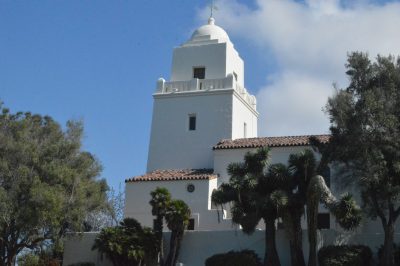
Continuing on, the battalion reached San Diego around 3:30 p.m., Jan. 29, 1847.
Of the approximately 500 that set out from Council Bluffs six months before, approximately 335 men and five women, arrived at the Mission Basilica San Diego de Alcalá. The unit spent two days in San Diego before returning back to San Luis Rey where they remained for about six weeks. Their stay at Mission San Luis Rey had its pros and cons. While the military barracks south of the Mission buildings were spacious enough to comfortably house the battalion, every room was reported to have been thoroughly infested with lice.
An anonymous battalion member recalled his discomfort in San Luis Rey.
“We were all soon covered with them and with all our cleaning rooms and washing and boiling our clothes we could not get rid of them, while we stayed in that place,” the solider said. “Every day it was common to go out, find a warm sun-shiny place, strip ourselves and hunt and kill lice. It was said the Indians used to eat them.”
March 14, 1847 – Cooke received orders to send one company to San Diego and the rest to Los Angeles. Taggart’s Company B was sent to San Diego. There, the foot-sore soldiers worked at a variety of jobs including burning bricks, digging wells and constructing homes. They also laid brick sidewalks, built chimneys, and whitewashed fences and buildings. No job was too small or too menial.
End of the road
The five companies of the Mormon Battalion, Army of the West, were discharged officially at Fort Moore in Los Angeles on July 16, 1847, one year after their enlistment.
The event was later recorded by a Mexican citizen – Don Lopez.
“There were brave men, standing in a solemn line,” he said. “These men’s hearts echoed with memories of duty and sacrifice. The air crackled with anticipation as they awaited the brief ceremony that would mark their release from service. These men, forged in the crucible of duty, had faced many hardships along their journey.
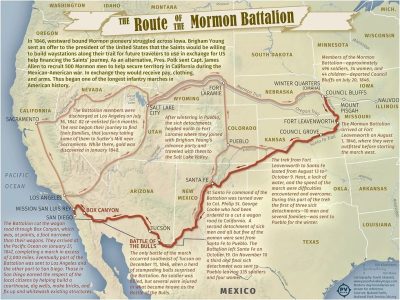
“Each man carried a unique burden – the memories etched into their souls; the scars hidden beneath their skin. And so, the men dispersed, their paths diverging like tributaries flowing toward distant horizons,” Lopez added. “As the sun dipped below the horizon, casting long shadows, they carried the weight of their service—a silent honor, a shared burden. The world continued to turn, but for those men, the echoes of their service lingered – a bridge between duty and freedom – etched in memory forevermore.”
The war resulted in a decisive American victory.
After months of fighting, the Treaty of Guadalupe Hidalgo ended the war, and Mexico recognized the cession of present-day Texas, California, Nevada and Utah as well as parts of present-day Arizona, Colorado, New Mexico and Wyoming.
With the annexation of more than 525,000 square miles of land, the Treaty of Guadalupe Hidalgo extended the boundaries of the United States west to the Pacific Ocean. This agreement, along with the 1853 Gadsden Purchase, created the southern border of the present-day United States.
The U.S. agreed to pay $15 million “in consideration of the extension acquired by the boundaries of the United States” and assumed $3.25 million of debt already owed by the Mexican government to U.S. citizens. Mexico relinquished its claims on Texas and accepted the Rio Grande as its northern border with the United States, a loss of 55% of its territory.
Other provisions included the protection of property and civil rights of Mexican nationals living within the new boundaries of the United States, the promise of the United States to police its boundaries and compulsory arbitration of future disputes between the two countries.
“When the Mormon battalion in (soldierly) array Trod to the wild war drum with banners displayed Their friends to protect and our Country to Aid The blood of our ancestors fired their veins And the Soldier remembered his fathers Campaigns Were proved to the world that we loyal remain And the spirit of freedom Still runs in our veins,” wrote Levi Hancock, member of the Mormon Battalion, Company E, in his diary.
This is the first in a three-part history on the Mormon Battalion, with the forthcoming part 2 set to cover the battalion’s history from Sutter’s Mill to St. George.
Author’s Note: This article was derived from credible firsthand accounts, family folklore and solid investigation conducted by a host of experts on the Mormon Battalion. The research presented may inadvertently contain contradictory information or journal entries that are based upon supposition.
Copyright St. George News, SaintGeorgeUtah.com LLC, 2024, all rights reserved.